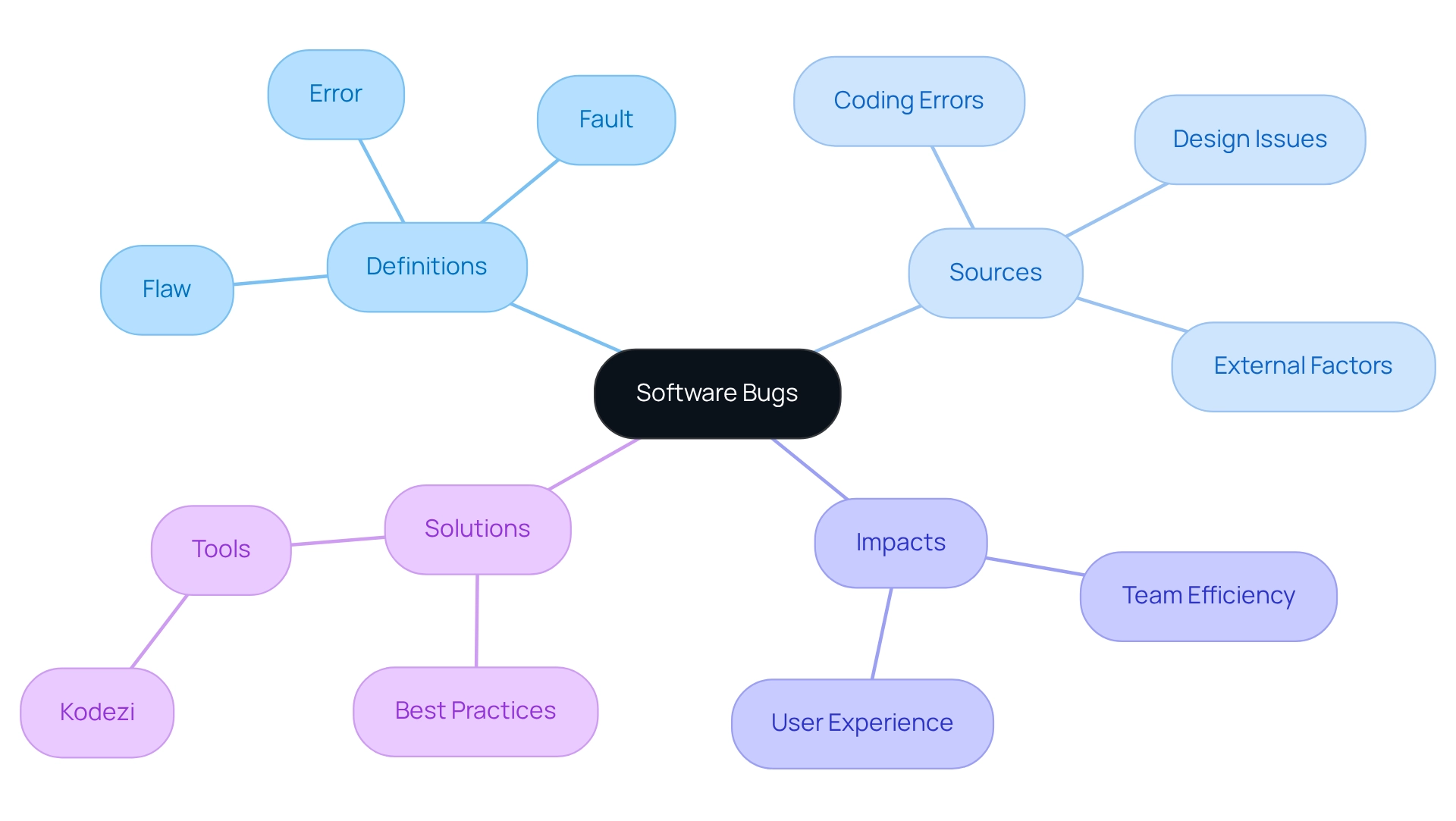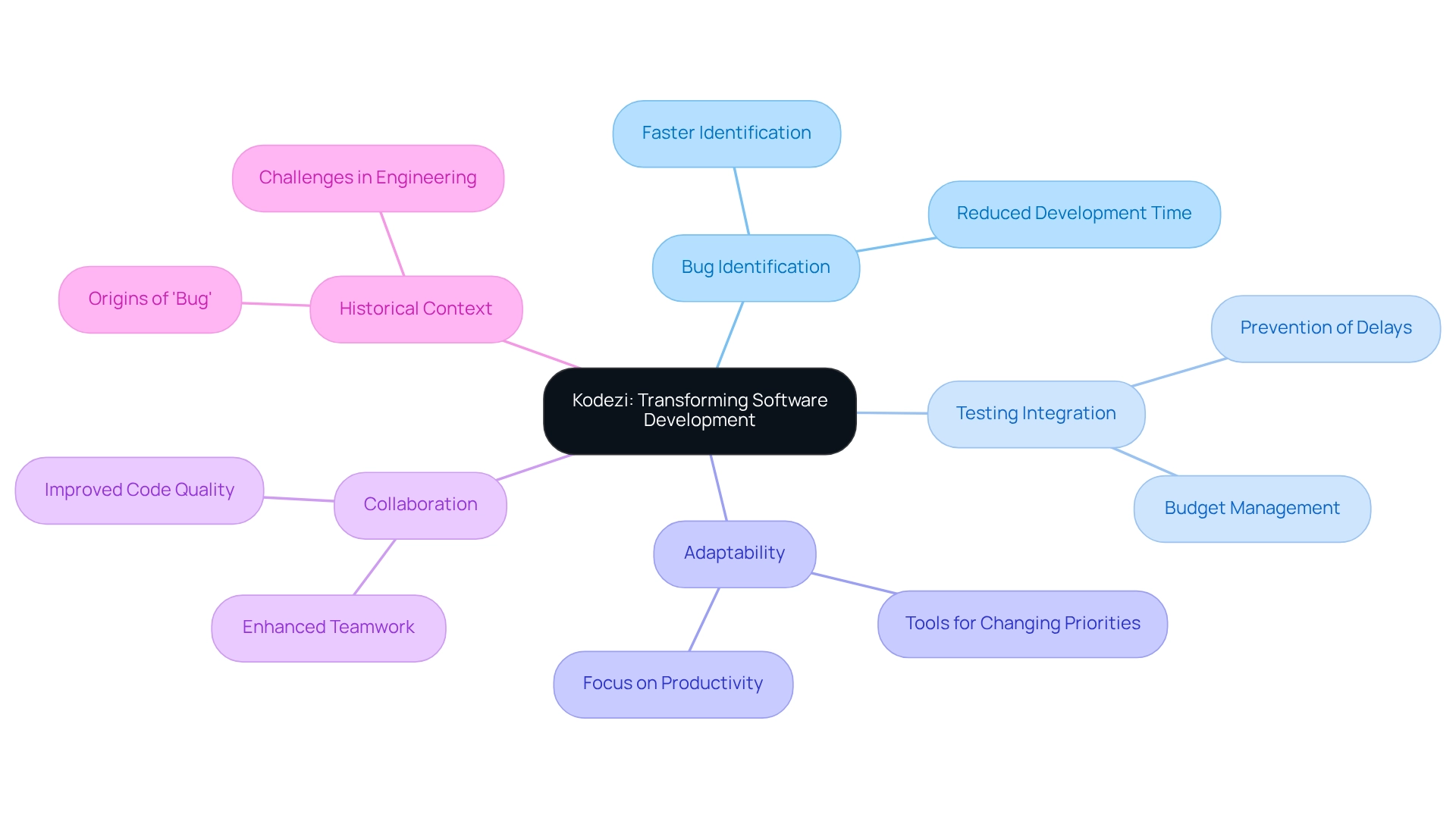Overview
The article highlights the challenges developers face with coding, particularly the presence of software bugs—flaws, faults, or errors in programs that result in incorrect or unexpected outcomes. These bugs can significantly impact software performance and user experience, leading to increased costs, project delays, and customer dissatisfaction. Understanding these issues is essential for developers, as it enables them to identify and address problems effectively.
Furthermore, Kodezi offers robust debugging practices and tools designed to tackle these challenges head-on. By providing features that streamline the debugging process, Kodezi empowers developers to enhance their productivity and improve code quality. For instance, its intuitive interface allows for quick identification of bugs, making it easier to resolve issues before they escalate.
In addition, using Kodezi not only helps in reducing the time spent on debugging but also fosters a more efficient coding environment. Imagine being able to focus on developing new features rather than getting bogged down by persistent bugs. This shift can lead to greater satisfaction for both developers and end-users alike.
To experience these benefits firsthand, explore the tools available on the Kodezi platform. With a commitment to improving software quality, Kodezi stands out as a valuable resource for developers seeking to enhance their coding practices. Why not take the next step and see how Kodezi can transform your development process?
Introduction
In the intricate world of software development, coding challenges are a constant hurdle that can disrupt projects, inflate costs, and diminish user satisfaction. How can developers effectively tackle these issues? Bugs, defined as flaws within a program, lead to a myriad of problems, from application crashes to security vulnerabilities. As technology continues to evolve, understanding the nature and origins of software bugs becomes crucial for developers and stakeholders alike. This is where Kodezi comes into play, offering innovative solutions to address these challenges.
By recognizing the pervasive nature of software bugs and adopting best practices for bug management, teams can enhance software quality and drive successful project outcomes. Kodezi provides specific features designed to improve productivity and code quality, allowing developers to focus on what truly matters—creating exceptional software. Explore the tools available on the Kodezi platform and discover how they can transform your development process.
Define Software Bugs: Core Concepts and Terminology
Coding challenges are a common hurdle for developers, often leading to frustration and inefficiencies. The bug software definition refers to a computer bug as a flaw, fault, or error in a program that results in incorrect or unexpected outcomes. Bugs can manifest in various forms, such as application crashes, incorrect outputs, or unintended behaviors. The bug software definition has become fundamental in program development, often used interchangeably with 'defect' or 'error.' Understanding these concepts is crucial for developers and stakeholders, as it lays the groundwork for identifying and addressing issues within systems.
Bugs can arise from multiple sources, including coding errors, design issues, or external factors that impact performance. In 2025, it is projected that around 70% of programming projects will be affected by flaws, underscoring their prevalence and the significant challenges they pose to development teams. However, viewing these issues as opportunities for learning and growth can lead to enhanced development outcomes, fostering a culture of continuous improvement.
Practical examples illustrate the impact of programming errors on user experience and team efficiency. For instance, a recent case study showed that timely notifications about failing tests significantly improved a team's ability to tackle critical issues, ultimately preserving high-quality software. By adopting best practices in issue management and utilizing automated tools like Kodezi—designed to resolve performance bottlenecks, identify security problems, and enhance code formatting—teams can not only reduce the number of issues but also elevate the overall quality of their applications. This leads to more successful projects and a clearer distinction from other tools like Copilot, which primarily focus on code completion rather than comprehensive debugging and optimization.
Are you ready to explore how Kodezi can transform your coding practices? Discover the tools available on the platform that can help you achieve greater productivity and code quality.

Trace the Origin of Software Bugs: Historical Context
In the world of coding, developers often encounter significant challenges. One such challenge is the complexity of debugging, which relates to the bug software definition, a process that can be both time-consuming and frustrating. How can developers streamline this process? Enter Kodezi, a platform designed to tackle these very issues. With features that simplify debugging and enhance collaboration, Kodezi stands out as a valuable tool for developers.
What benefits does Kodezi offer? Firstly, the bug software definition allows for faster identification of bugs, which can drastically reduce development time. Additionally, by integrating testing into the development process, Kodezi helps prevent delays in release dates and budget overruns. This balance between speed and thorough testing is crucial for ensuring quality in software development, reflecting the bug software definition; furthermore, it’s important to consider the common pitfalls in project management. A quote from Wrike highlights that changing priorities and project objectives frequently lead to project failures. Kodezi addresses these challenges by offering tools that adapt to shifting project needs, ensuring developers remain focused and productive.
In addition to these features, Kodezi fosters a collaborative environment, allowing teams to work together more effectively. This not only improves productivity but also enhances code quality. By understanding the historical context of debugging and its evolution, developers can appreciate how Kodezi is shaping contemporary engineering practices.
Are you ready to elevate your coding experience? Explore the tools available on the Kodezi platform and discover how they can transform your approach to software development.

Identify Types of Software Bugs: Common Classifications
Program flaws can significantly impact application performance and user experience. Understanding the bug software definition and its flaws is crucial for developers facing coding challenges. Common classifications include:
- Functional Issues: These occur when an application fails to execute its intended function, resulting in erroneous outputs or behaviors. For instance, a mobile application that crashes when a user attempts to save a file exemplifies a functional bug, directly affecting satisfaction and retention.
- Performance Bugs: These affect the speed and efficiency of the software, leading to slow response times or excessive resource consumption. Imagine a web application that takes too long to load; such delays can frustrate users and drive them away. Kodezi addresses these issues by resolving performance bottlenecks, ensuring a more seamless experience.
- Security Flaws: Vulnerabilities expose applications to potential attacks, compromising data and system integrity. A flaw that allows unauthorized access to sensitive information can have severe consequences for both users and organizations. Kodezi helps maintain security compliance by identifying and resolving these vulnerabilities.
- Compatibility Issues: These arise when software fails to operate correctly across different environments, devices, or operating systems. For example, an application that works seamlessly on one browser but crashes on another limits its usability.
- Logical Bugs: These occur due to errors in the program's logic, leading to unexpected outcomes. A calculation mistake in a financial application can result in erroneous billing, impacting client trust. Comprehending these classifications enables developers to identify and prioritize fixes based on the bug software definition efficiently.
With Kodezi's AI-driven automated debugging capabilities, users can instantly identify and resolve these issues, ensuring their codebase adheres to the latest security best practices and coding standards. Furthermore, the complexity of validating applications across various fields highlights the need for robust issue-tracking solutions, as application flaws can significantly affect development processes and overall business results. Kodezi empowers over 1,000,000 users by enhancing programming efficiency and providing an independent solution for B2B engineering teams to improve code quality and resolve issues before production.

Examine the Impact of Bugs on Software Development: Consequences and Challenges
The existence of program errors, as outlined in the bug software definition, can have significant consequences for development groups and companies. Issues can lead to increased costs, project delays, customer discontent, and reputation damage.
Increased Costs: Resolving issues, especially those discovered late in the development cycle, can significantly raise project budgets. Research shows that a staggering 60-80% of development expenses may arise from error correction, with the total cost of poor quality in the U.S. reaching approximately $2.08 trillion.
Project Delays: Errors frequently lead to unexpected delays, disrupting project timelines and endangering delivery schedules. For example, firms such as Stripe and Shopify have encountered project delays because of coding errors, emphasizing the essential requirement for efficient oversight and testing.
Customer Discontent: Issues that undermine experience can result in annoyance, reduced involvement, and eventually, client loss. User input is crucial for recognizing these problems after launch, as unresolved issues can greatly affect user retention.
Reputation Damage: High-profile problems can severely harm a company's reputation, eroding trust among users and stakeholders. The outcomes of such events can be enduring, influencing future business prospects. These effects emphasize the importance of adopting strong testing and debugging methods to reduce the risks linked to the bug software definition associated with programming errors. By investing in error monitoring tools and fostering collaboration between QA and development teams, organizations can enhance software reliability and protect their bottom line.

Conclusion
The pervasive issue of software bugs presents significant challenges for developers and organizations alike, affecting project costs, timelines, and user satisfaction. By understanding the core concepts and classifications of software bugs, teams can better identify and address these flaws, ultimately leading to improved software quality. This historical context illustrates that bugs are not a new problem; rather, they have evolved alongside technology, necessitating advanced debugging techniques and tools.
Investing in robust bug management practices is essential for mitigating the consequences of software bugs. The financial implications are stark, with a substantial portion of development costs attributed to fixing bugs. Additionally, project delays and user dissatisfaction can have lasting effects on a company's reputation. Tools like Kodezi empower developers to tackle these issues head-on, enhancing productivity and ensuring that code quality remains a priority throughout the development lifecycle.
Ultimately, the key to successful software development lies in recognizing bugs as opportunities for growth and learning. By fostering a culture of continuous improvement and leveraging innovative solutions, development teams can navigate the complexities of software creation. This enables them to deliver exceptional products that meet user needs and withstand the test of time. Embracing these strategies not only enhances project outcomes but also sets the stage for future advancements in the ever-evolving landscape of technology.
Frequently Asked Questions
What is the definition of a software bug?
A software bug is defined as a flaw, fault, or error in a program that results in incorrect or unexpected outcomes, such as application crashes, incorrect outputs, or unintended behaviors.
What are some common sources of software bugs?
Software bugs can arise from coding errors, design issues, or external factors that impact performance.
How prevalent are bugs in programming projects?
It is projected that around 70% of programming projects will be affected by flaws in 2025, highlighting the significant challenges they pose to development teams.
How can viewing bugs as opportunities benefit development teams?
Viewing bugs as opportunities for learning and growth can lead to enhanced development outcomes and foster a culture of continuous improvement.
What impact do programming errors have on user experience and team efficiency?
Programming errors can negatively impact user experience and team efficiency, but timely notifications about failing tests can significantly improve a team's ability to tackle critical issues, ultimately preserving high-quality software.
What are some best practices for managing software issues?
Best practices include adopting effective issue management strategies and utilizing automated tools designed to resolve performance bottlenecks, identify security problems, and enhance code formatting.
How does Kodezi differ from tools like Copilot?
Kodezi focuses on comprehensive debugging and optimization, while tools like Copilot primarily focus on code completion.




